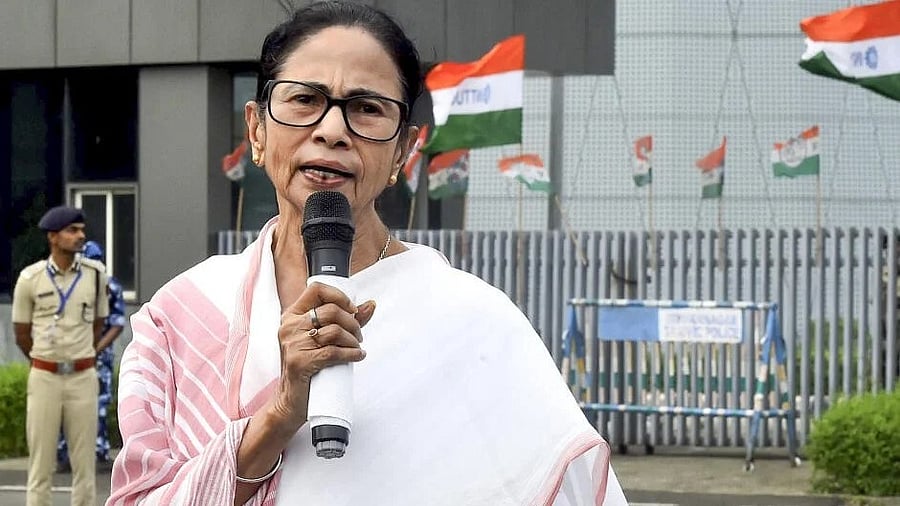
West Bengal Chief Minister Mamata Banerjee
Credit: PTI Photo
The Election Commission of India's launch of the second phase of the Special Intensive Revision (SIR) of electoral rolls, beginning October 28 across 12 states, signals a significant shift from the Bihar exercise notified in June. Unlike Bihar's more targeted approach, this pan-India push—covering over 51 crore voters—intensifies scrutiny on voter documentation, prompting claims of deletions and verifications.
In poll-bound West Bengal, where Assembly elections are due in the first half of 2026, the SIR arrives amid a charged political landscape. Mamata Banerjee's Trinamool Congress (TMC) has held power for three consecutive terms since 2011, fostering undeniable anti-incumbency over issues like governance lapses and violence. Yet, the opposition Bharatiya Janata Party (BJP) grapples with internal fractures: leadership vacuums, infighting, and struggles to build grassroots machinery or craft a compelling narrative beyond sporadic attacks on the TMC's alleged patronage networks.
The BJP's West Bengal unit has long agitated for rigorous voter list purges, zeroing in on illegal Bangladeshi infiltration as a core plank. With the SIR underway, party workers proclaim vindication through slogans like ‘No SIR, No Vote’, positioning it as a bulwark against demographic shifts. But this gambit risks playing into Banerjee's hands.
A narrative virtuoso since her early days, challenging the Left's dominance, Banerjee had already, before the SIR, transformed the deportations of suspected illegal Bangladeshi immigrants from BJP-ruled states into an issue of targeted attacks on the Bengali language and identity. By citing examples of harassment against Bengali-speaking workers from West Bengal — who are Indian citizens, not Bangladeshis — in places like Assam and Delhi, she reframed crackdowns on infiltration as systematic ethnic profiling and persecution of Bengalis at large.
Meanwhile, the SIR provides her a fresh theme: the drive is cast as a disguised precursor to the National Register of Citizens (NRC), something she warns will target minority communities, especially Muslims.
In the 2021 Assembly polls, the Muslim vote consolidated decisively behind the TMC, allowing the party to withstand what could otherwise have been strong anti-incumbency headwinds. Analyses suggest that in the 2016 Assembly elections, around 50% of Muslim voters supported the TMC. By 2021, this share had risen to nearly 70%, a sharp increase driven by communal polarisation. In effect, the Muslim voters who had earlier backed the Left-Congress alliance shifted almost entirely to the TMC.
Against this backdrop, the BJP’s recent ‘SIR gambit’ — combined with its rhetoric portraying Bengal’s Muslims as ‘Rohingyas’ or ‘illegal immigrants’ without evidence — appears to be a calculated attempt to communalise the electoral narrative once again. Ironically, the SIR exercise has given Banerjee an indirect opportunity to re-engage with her Muslim voter base without overtly invoking identity politics.
Since 2021, the Left-Congress combine has regained sections of Muslim support in local contests, such as the 2023 Panchayat polls and the Sagardighi and Ballygunge by-elections. The SIR issue could take away the recent Muslim support the Left-Congress had gained.
Notably, over the past few years, she has sought to counter the BJP’s charge of ‘appeasement politics’ by emphasising her Hindu identity — at times asserting that she is a Brahmin, and at others by inaugurating religious projects such as the Jagannath temple in Digha. The SIR process, therefore, enables her to reposition herself politically — reaching her minority constituency subtly, while continuing to project a balanced, secular image.
Complicating matters, the SIR stirs unease among the very Hindu communities the BJP courts. Matuas, descendants of Dalit refugees from East Bengal, dominate about 40-45 assembly segments, while Rajbanshis influence ~20 seats in northern tea belt areas. These groups swung toward the BJP in 2019 and parts of 2021, lured by the CAA. Yet, incomplete implementation leaves many without updated documents, fearing voter list deletions. The TMC leadership is capitalising on this fear.
The SIR may end up strengthening Mamata Banerjee’s TMC in West Bengal by stoking fears of exclusion and consolidating polarised blocs, as the BJP’s immigration narrative alienates voters, and a divided Opposition gives TMC another potential electoral edge.
Sayantan Ghosh is a research scholar and teaches journalism at St. Xavier’s College (autonomous), Kolkata. X: @sayantan_gh.
(Disclaimer: The views expressed above are the author's own. They do not necessarily reflect the views of DH.)